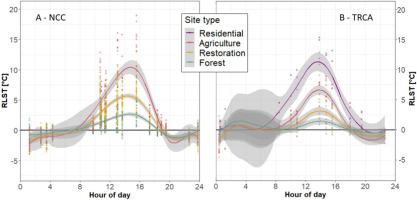Remote Sensing of Environment ( IF 11.1 ) Pub Date : 2022-07-23 , DOI: 10.1016/j.rse.2022.113178 L. Jonas Hamberg , Joshua B. Fisher , Jonathan L.W. Ruppert , Jessica Tureček , Dean H. Rosen , Patrick M.A. James

|
Restoration of temperate forests alters the diurnal dynamics of land surface temperature (LST) and evapotranspiration (ET) through increases in biomass, diversity, and complexity. The ECOsystem Spaceborne Thermal Radiometer Experiment on Space Station (ECOSTRESS) is the first space-based thermal imaging instrument that allows for a study of diurnal LST and ET dynamics at a moderate spatial resolution (70 × 70 m).
We quantified, compared, and modeled the LST and ET dynamics of two groups of forest restoration sites (43 sites in total, between 2 and 75 ha) in Southern Ontario, Canada that were initially restored from mainly agriculture between 2007 and 2019. We included all useable LST (n = 29) and ET (n = 9) ECOSTRESS image products from a full growing season in 2020 (June 1st to September 30th). Forest restoration sites were compared by age and against agriculture (pre-restoration state), mature forest (post-restoration state), and suburban residential sites (competing land use).
The ability of forest restoration sites to buffer temperatures was highest in the afternoon, around 14:00 local time (EDT). As predicted, restoration sites were significantly cooler (x̄ 4.4–7.4 °C) than residential and agricultural areas and significantly warmer (x̄1.6–2.9 °C) compared to mature reference forest sites at both groups of sites. Relative diurnal (24-h) LST variability of forest and restoration sites was also significantly lower (0.9–2.9 °C) compared to agriculture and residential sites (3.3–5.2 °C). Daytime LST decreased significantly by 0.1 °C (3.1%), per year since restoration for one of the groups of sites relative to nearby mature reference forest sites as per a linear mixed effects regression model. It would take these sites ~30 years to reach the same buffering as mature forests. In characterizing ET dynamics of a subset of sites, we found that more recently restored sites had a statistically significant higher overall ET than older ones and that daytime relative instantaneous ET decreased with years since restoration. The variation explained by the ET model was however low.
Our study provides insights into how diurnal forest ecosystem energy conversion and storage dynamics changes over time after restoration. These diurnal thermal dynamics impact wildlife habitat as well as human wellbeing. The change in thermal buffering over time could be used to assess the pace and trajectory of restoration by managers. The thermal buffering provided by restored forest can also be quantified as an ecosystem service. As such, the study demonstrates the utility and also limitations of novel thermal remote sensing methods, using free and publicly available imagery from ECOSTRESS.
中文翻译:

使用 ECOSTRESS 热成像评估和模拟森林恢复中的昼夜温度缓冲和蒸散动态
温带森林的恢复通过增加生物量、多样性和复杂性来改变地表温度 (LST) 和蒸散量 (ET) 的昼夜动态。空间站上的 ECOsystem 星载热辐射计实验 (ECOSTRESS) 是第一个基于空间的热成像仪器,可以在中等空间分辨率 (70 × 70 m) 下研究昼夜 LST 和 ET 动力学。
我们量化、比较和模拟了 2007 年至 2019 年期间最初从主要农业恢复的加拿大安大略省南部两组森林恢复地点(总共 43 个地点,面积在 2 到 75 公顷之间)的 LST 和 ET 动态。我们包括2020 年(6 月 1 日至 9 月 30 日)完整生长季节的所有可用 LST ( n = 29) 和 ET ( n = 9) ECOSTRESS 图像产品。森林恢复地点按年龄和农业(恢复前状态)、成熟森林(恢复后状态)和郊区住宅用地(竞争性土地使用)进行比较。
下午,当地时间 14:00 左右(美国东部时间),森林恢复地点缓冲温度的能力最高。正如预测的那样,与两组站点的成熟参考森林站点相比,恢复站点的温度明显低于住宅区和农业区(x̄ 4.4–7.4 °C),并且温度显着升高(x̄1.6–2.9 °C)。与农业和住宅区 (3.3-5.2 °C) 相比,森林和恢复地点的相对昼夜 (24 小时) LST 变异性也显着降低 (0.9-2.9 °C)。根据线性混合效应回归模型,相对于附近成熟参考森林站点的一组站点恢复以来,日间 LST 每年显着下降 0.1 °C (3.1%)。这些地点大约需要 30 年才能达到与成熟森林相同的缓冲。在表征一个站点子集的 ET 动态时,我们发现最近恢复的站点的总体 ET 比旧站点具有统计显着性更高,并且白天相对瞬时 ET 随着恢复后的年限而减少。然而,ET 模型解释的变化很小。
我们的研究提供了有关恢复后昼夜森林生态系统能量转换和储存动态如何随时间变化的见解。这些昼夜热动态影响野生动物栖息地以及人类福祉。热缓冲随时间的变化可用于评估管理者恢复的速度和轨迹。恢复森林提供的热缓冲也可以量化为生态系统服务。因此,该研究使用来自 ECOSTRESS 的免费和公开可用的图像展示了新型热遥感方法的实用性和局限性。











































 京公网安备 11010802027423号
京公网安备 11010802027423号